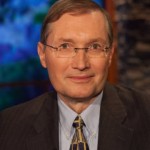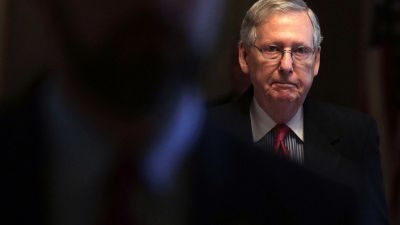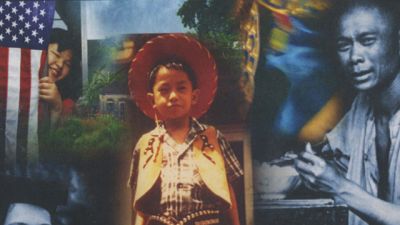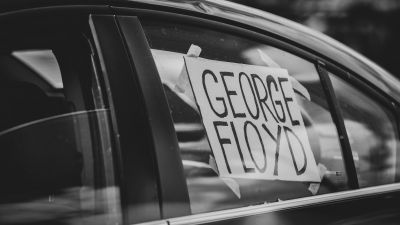
President-elect Donald Trump speaks at a news cenference at Trump Tower on Jan. 11, 2017 in New York City — his first official news conference since the November elections. (Photo by Spencer Platt/Getty Images)
The election of Donald Trump has triggered as much wonderment abroad as it has in the United States. David Runciman, a professor of politics at the University of Cambridge, has written in the London Review of Books a provocative reflection on the nature of democracy in the age of Trump: “Is this how democracy ends?” There is much to praise in his essay, including his heavy qualification that we really don’t know for sure if what we are seeing is the end phase of mature Western democracies since we do not have the appropriate historical precedents to be certain.
Runciman is correct; as an admirer of Karl Popper, I believe that there is no such thing as historical determinism, either in the form of the Marxist dialectical process, or in the guise of its mirror image, the invisible hand of laissez-faire. Accordingly there is no surefire way to tell in advance whether Trump, Marine Le Pen or Geert Wilders would spell the end of democracy as we have known it. History, as Popper would tell us, is an open system, full of contingency. Waterloo, the Battle of Britain and Stalingrad were all close-run things.
That said, Runciman may in fact be too optimistic. He makes much of the evidence that post-election violence in America was scattered and relatively minor. There were no pitched battles in the streets on the scale of Berlin in 1932, no tanks on the Washington Mall and no generals appearing on television to announce a curfew or to say that order has been restored. But that establishes an awfully easy test for Trump to prove he is harmless, especially as he had not even assumed office at the time of the author’s writing. We do not know what the next four years have to offer, particularly when Trump begins to dismantle government programs on which people rely for subsistence, or when he ignites a trade war with China and downscale consumers, the archetypal Walmart customers, suddenly discover either that the shelves are empty or that their cost of living has increased by 45 percent.
If we look at Russia in the age of Vladimir Putin, we also see no tanks in the streets, bloody battles between opposing factions or generalissimos restoring order. Elections there proceed in an orderly manner, as they did last September. This is what managed democracy looks like. Runciman may argue Russia was never a mature Western democracy, and he would be right. But it also shows that an absence of chronic civil unrest or domestic military intervention is not a benchmark for deciding whether a country remains in the camp of liberal democracies. Even countries visibly undemocratic by Western standards can maintain a façade of civil order and normality. Hungary, an EU member since 2004 after 84 percent of the electorate approved accession, is undeniably regressing toward a one-party, authoritarian state under Brussels’ very nose.
Just as Putin’s United Russia Party has moved to disqualify troublesome opposition parties from the ballot and centralize power around the president, and as Viktor Orbán’s Fedesz Party has weakened those Hungarian institutions that challenged his power, Trump’s Republican Party has been laying the institutional groundwork for illiberal democracy for several years. States whose legislatures and governorships are controlled by Republicans not only gerrymander federal congressional districts with scientific precision, they have restricted voter qualifications, polling hours and locations as a way of hobbling their opponents. When North Carolina voters elected a Democrat as governor this November, the Republican legislature passed measures to strip the governorship of many of its powers. Since the governor-elect had not assumed office yet, he was in no position to veto it.
Even more questionable are some of Trump’s own actions as president-elect. When do American politicians hold rallies? Typically, when they are running for office. The freshly elected Trump, rather than studying up for the job or attending intelligence briefings, went on an extended “thank you tour,” staging political rallies across the country. As the American media have noted, these are not meant to heal divisions and unite the country; they have more to do with score-settling with his opponents while stoking his political base. There was no magnanimity or graciousness as he continued to attack his bested opponent, Hillary Clinton.
He also said he intends to maintain his private security squad even after assuming office. Quite apart from its redundancy, given the presence of the taxpayer-provided Secret Service, the specter of a national leader retaining a private security contingent, particularly one that distinguished itself by roughing up protesters at campaign rallies, is troubling indeed. Bringing up party rallies and private security forces may be condemned as an inadmissible argumentum ad Hitlerum, but it is also hardly grounds for complacency given the violent imagery of Trump’s rhetoric.
Runciman is absolutely correct in pointing out the hidden problems that Trump is incapable of solving, particularly the rise in the death rate in parts of Appalachia, the Midwest and the American South. This phenomenon arises from a social crisis characterized by underemployment, inadequate health care and community decay that culminates in epidemic use of opioids and alcohol. What he neglects to emphasize is that these are precisely the areas where Trump’s support is the strongest. During the primaries, pollsters began noticing his electoral support correlated significantly with counties having the highest number of opioid addiction cases. In the general election, Trump outperformed expectations in key Rust Belt states that he had to win in order to gain an Electoral College majority; he ran particularly strongly where the opioid epidemic was acute. Correlation is not causation, of course, but opioid use may be a symptom of a cluster of social dysfunctions that lead to voters being attracted by Trump’s message.
It is at this point where Runciman’s thesis goes seriously wrong. He says that voters chose Trump to shake things up precisely because they knew he couldn’t do it; in other words, they counted on the political system they rail against as worthless to be worthy enough to protect them from the consequences of their foolish mistake. The author shows either a remarkable ability to infer the thought processes of an unemployed Kentucky laborer without health insurance, or he is guilty of constructing an attractive-sounding paradox that is a little too clever. If he is right, then Trump was elected in some colossal mistake right out of an O. Henry short story. But among his most ardent supporters in the blighted areas of the Rust Belt, it is possible they felt the entire system had failed them and they had nothing left to lose. Indeed, one of the striking characteristics of some Trump supporters is a kind of embittered nihilism and a perverse glee at bringing down the system. These, of course, are by no means all of his voters, although they may have been enough to make the difference.
As for the rest, American party politics has become so polarized and tribal identification with party sufficiently intense, that a Republican national candidate is virtually guaranteed a reliable 40 percent floor at the polls, and the rest of what he gets is what he earns. That 40 percent will vote for the Republican on the ballot regardless of whether the candidate has two horns and a tail; considerations as to whether the system will save them from their choice does not enter their heads.
And even if Trump were elected out of voters’ mistaken premises, what of it? Does that imply Trump will not perform the many potentially destructive acts he has promised to his supporters and threatened to his opponents? Despite his unprecedentedly large popular vote loss as a winning candidate, he and his operatives call his Electoral College victory a landslide and act as if they possess the most overwhelming mandate in history. If the past is any precedent, the signs are not good. George W. Bush won under similar electoral circumstances and proceeded to bulldoze through a policy of stunning fiscal irresponsibility while provoking a war that may have been America’s single greatest foreign policy blunder since Vietnam — or possibly ever.
As to Trump’s carrying out his agenda, only time will tell, and here Runciman may be a little too optimistic about the resiliency of American institutions. As a former career congressional staff member, I had extended experience seeing them close up and interacting with them. One of those institutions is the campaign-industrial complex that comprises both major American parties. Trump, operating from his private playbook, handily dispatched the Republican wing of that complex in the primaries and went on to defeat Hillary Clinton’s extremely well-funded machine in the general election. As for the military-industrial-intelligence complex that Runciman suspects will save the day, I doubt senior personnel in that establishment are immune from the blandishments of career advancement or the object lesson of being sacked. Bush and his vice president succeeded in concocting a fictitious pretext for unprovoked war by jawboning intelligence agencies to give them what they wanted. “Go along to get along” is the Washington Beltway’s prime directive, and why will it be different this time?
One of the glaring omissions in the essay was the absence of any discussion of terrorism as a potential solvent of liberal democracy. It is precisely here that the example of Bush’s pretext for the invasion of Iraq is instructive. The terror attacks of Sept. 11, 2001 unhinged a sizable slice of the American people; the invasion of Iraq and its unsatisfactory resolution amplified the syndrome; the rise of ISIS may have brought the public to a tipping point where a caudillo like Trump became possible. Nor are other polities immune: the Madrid train bombing of 2004 and the London underground attack of 2005 did not engender panicked fear-mongering in Europe, but the civil war in Syria and the terrorist attacks that followed, all of them on a smaller scale than Madrid, have roiled the continent in a way that is seriously upsetting political stability there.
It is well and good for optimists to say Americans should stop being so paranoid, and to point out that the opioid epidemic is a much greater problem because it kills vastly more Americans than terrorism. But perception is political reality. Fear of terrorism has upset the post-World War II consensus about the balance between freedom and security in the Atlantic democracies. Personal privacy and freedom of movement are essential aspects of the autonomy and dignity of the individual human being. They constitute a bedrock principle of a liberal social order; terrorism erodes these, and the all-but-interminable duration of the war on terrorism suggests time may be on the side of illiberalism.
The parliamentary liberalism unevenly developed over the past two centuries maintains another central tenet: that the litmus test of truth is not blind faith or coerced assent, but corroborable facts and evidence agreed to by all rational observers. This standard has come under attack in America as digital media have fractionated to serve hermetic partisan groups who believe only that which confirms and amplifies their existing biases. The new approach was best summed up by Scottie Nell Hughes, a Trump campaign surrogate who told a stupefied moderator and panelists on a radio talk show that “There’s no such thing, unfortunately, anymore, as facts.”
She went on: “And so Mr. Trump’s tweet[s] amongst a certain crowd, a large — a large part of the population, are truth. When he says that millions of people illegally voted, he has some — in his — amongst him and his supporters, and people believe they have facts to back that up. Those that do not like Mr. Trump, they say that those are lies, and there’s no facts to back it up. So…”
One of the paradoxical twists of history is that when leftist deconstructionists posited the notion of situational truth in the 1970s, the American right responded with fury against their “moral relativism,” a denunciation that became the leitmotif of staunch conservatives like Ronald Reagan’s education secretary, William Bennett. Now, among the Trump supporters, who have usurped the mantle of true conservative standard-bearers, the very idea of truth is relative to the beliefs of the observer.
Many observers, Runciman included, see Trump as a maverick not in tune with the American security apparatus. To some extent, this is true, but the full relationship is more differentiated than that. It is by now universal wisdom that the subversive rhetoric and insurrectionist tactics of the GOP, the tea party and their associated propaganda outlets helped create Trump, however much the party establishment claimed to have detested him. But even though the GOP in the era of the tea party sired Trump, it shares parentage with the transpartisan national security complex of the United States. Politicians, generals, CIA directors, think tank warriors and terrorism “experts” have been driving a message of fear about terrorism into our heads for a decade and a half — a fear that has activated the latent authoritarianism and paranoia that lurk in all too many ordinary people.
This dynamic helps explain why Trump’s candidacy took off like a moon rocket in November and December of 2015, the period of the terrorist attack in Paris and the murders in San Bernardino. Government officials and the corporate media whipped up a mood in the country that approached hysteria; Trump deftly exploited that mood to his advantage. By being the only politician brazen enough to openly advocate torture — not merely to gain information, but to inflict pain for its own sake — he tapped into the revenge fantasies of millions of Americans who have been fed a steady diet of fear since 9/11.
Voters in the Republican primary in South Carolina who handed Trump a walkover victory declared terrorism to be their foremost concern, one that eclipsed a low-wage economy — deteriorating living standards that have led to an actual increase in the death rate of the GOP’s core demographic of late-middle-aged, non-college educated whites; and the most expensive and least available health care in the so-called developed world. So while Trump — a Vietnam-era draft avoider who appeared not even to know what the nuclear triad was — could hardly be considered a product of the national security sector, his demagogic skills and authoritarian demeanor placed him in a far better position than his rivals to exploit the national neurosis created by the war on terror.
On the question of Trump’s authoritarian appeal Runciman states, “It is sometimes said that Trump appeals to his supporters because he represents the authoritarian father figure who they want to shield them from all the bad people out there making their lives hell. That can’t be right: Trump is a child, the most childish politician I have encountered in my lifetime.” Of course, Trump would appear as a child to a cultured and educated product of Cambridge and an exponent of liberal democracy. His babyish tantrums and 4-in-the-morning tweets are hardly indicative of an adult in control of his emotions. But the problem with the author’s reasoning is that Trump’s demeanor might well appear reminiscent of an authoritarian father in a West Virginia mining town or a South Carolina trailer park. The American media have collected dozens of quotes from Trump supporters who used father metaphors to describe him; The Washington Post chronicled the story of one rabid supporter, a late-middle-aged woman in Pennsylvania, who habitually referred to Trump as “Big Daddy.” It hardly requires the services of Dr. Freud to infer that there’s something going on there, and it assuredly doesn’t validate the rational choice theory beloved of sociologists.
Donald Trump is one aspect of a much larger story: the fraying of post-World War II institutions like the IMF, the UN and NATO. The oldest of these are now seven decades old. If you count its embryonic precursor, the European Coal and Steel Community, the EU is almost that old. It may be that these institutions have a natural lifespan. More likely, perhaps, there was a wrong turning about midway through the postwar period, when Britain and the United States went all in for laissez-faire fundamentalism, with almost all of the Atlantic democracies following in their wake. These policies exacerbated what was already bound to be a difficult adjustment for Western industrial workers when China and other East Asian countries became manufacturing powerhouses.
In some ways Trump and his European soul mates are populist reactions, albeit authoritarian ones, to voters’ dismay over the mature democracies’ own slide into illiberalism. To wall off their pet economic nostrums from popular challenge, elites wrote binding clauses into trade treaties to prevent national or regional legislatures from challenging corporate prerogatives on safety or environmental grounds. Brussels and the European Central Bank forbade member governments, regardless of their popular mandate, from undertaking measures to help their citizens after the 2008 economic crash. The geopolitical situations may be different, but rigid austerity was as much a mistake in the Greece or Italy of today as it was in Chancellor Brüning’s Germany of 1932, or Prime Minister Ramsay MacDonald’s Britain of the same year.
So perhaps democracies die of old age and we cannot quite see which event will cause their final cardiac arrest. But more likely, their leaders make avoidable mistakes, and then persist in them because their ideological disposition causes them to resist the warning signs of danger ahead. If authoritarian populism is the wave of the future, its midwife is neoliberal economics turned punitive and illiberal.




